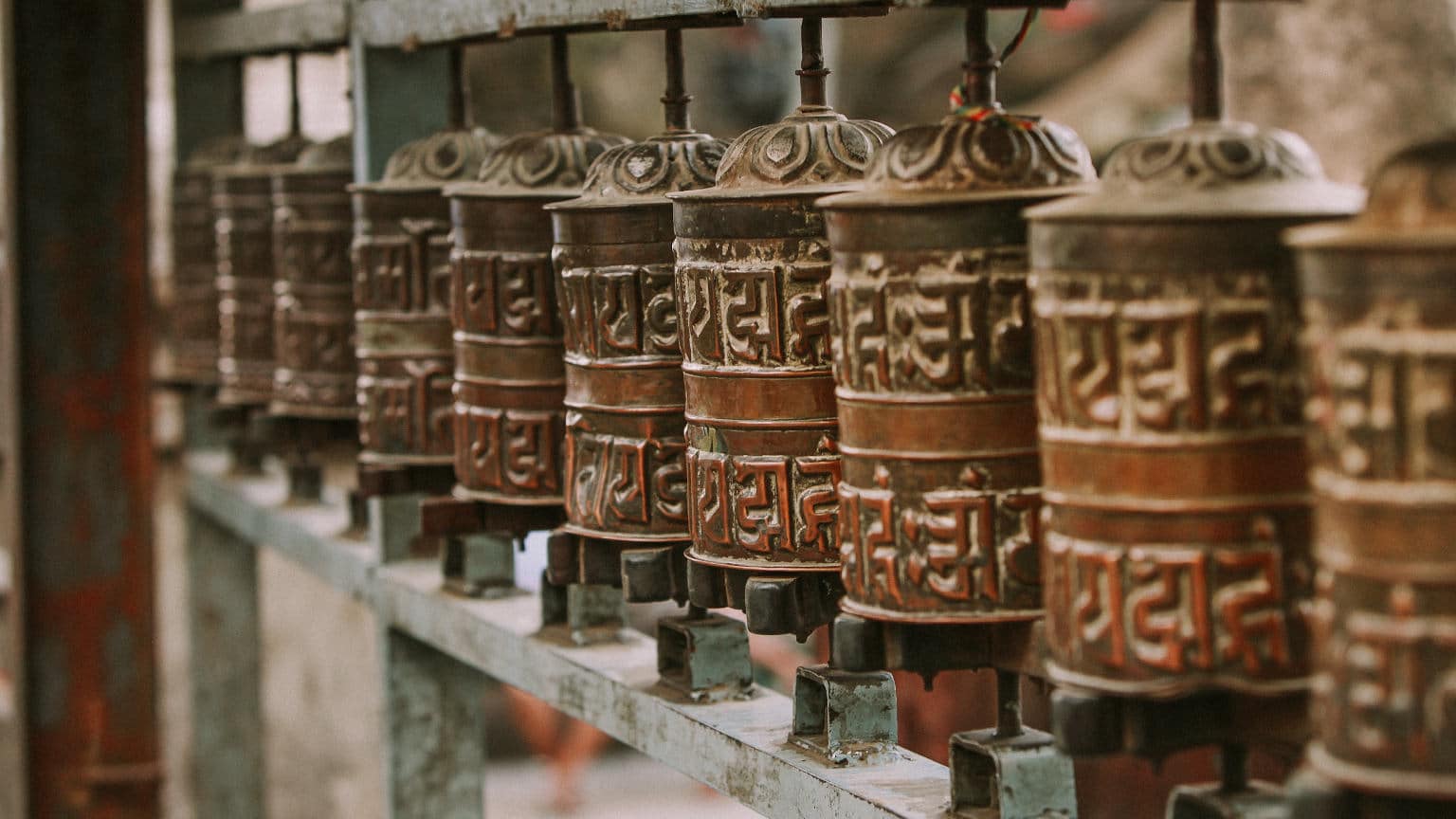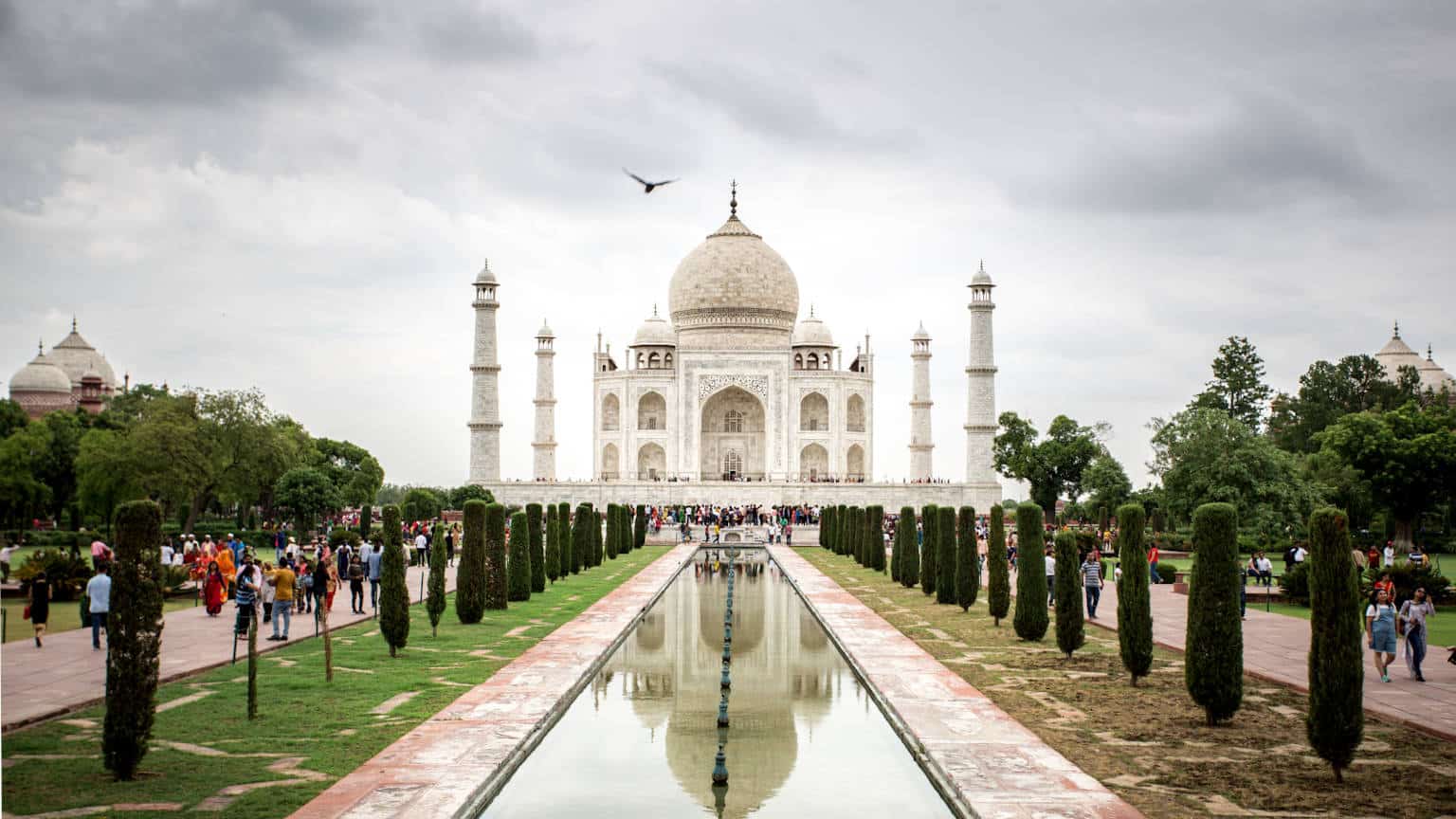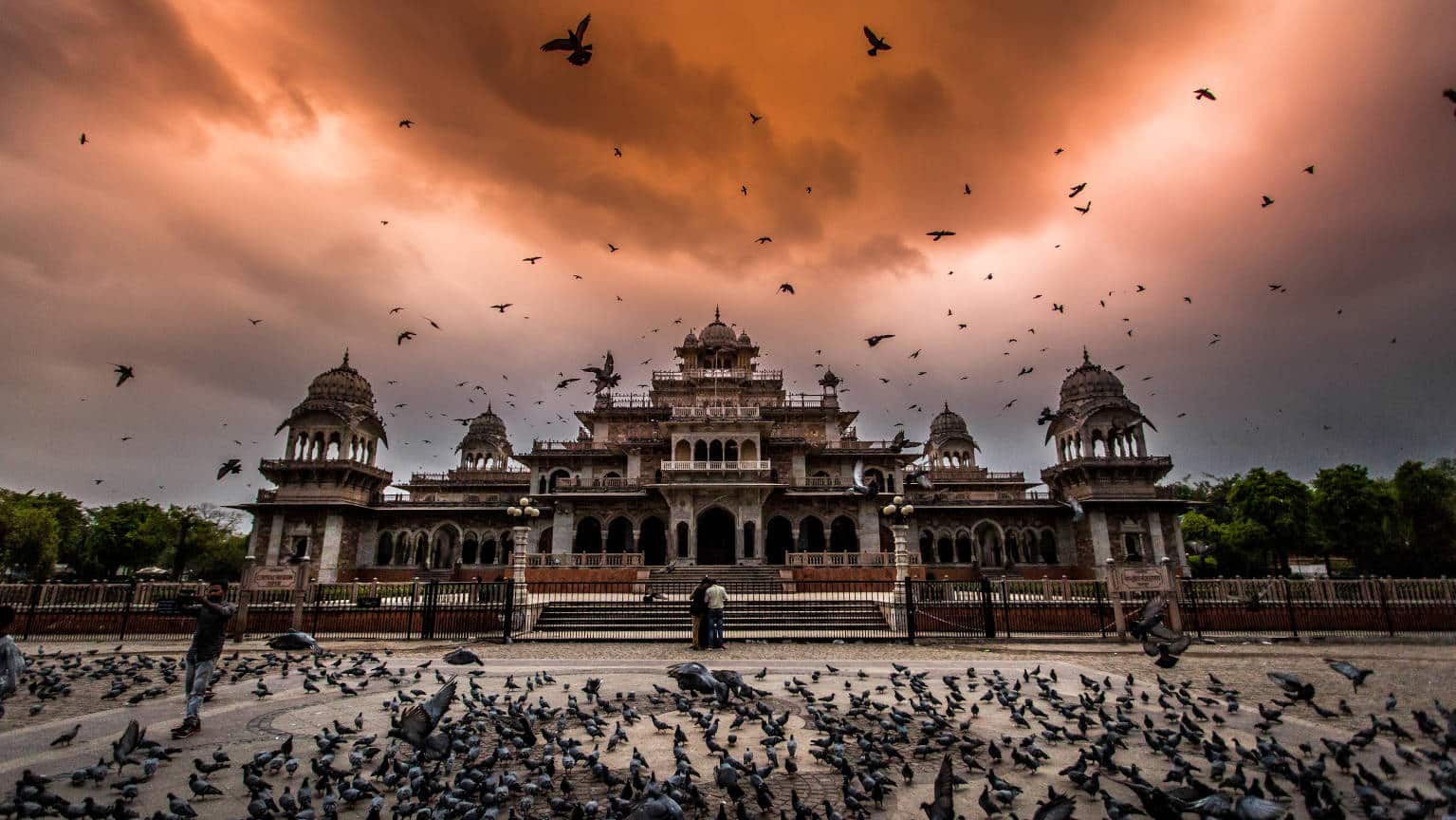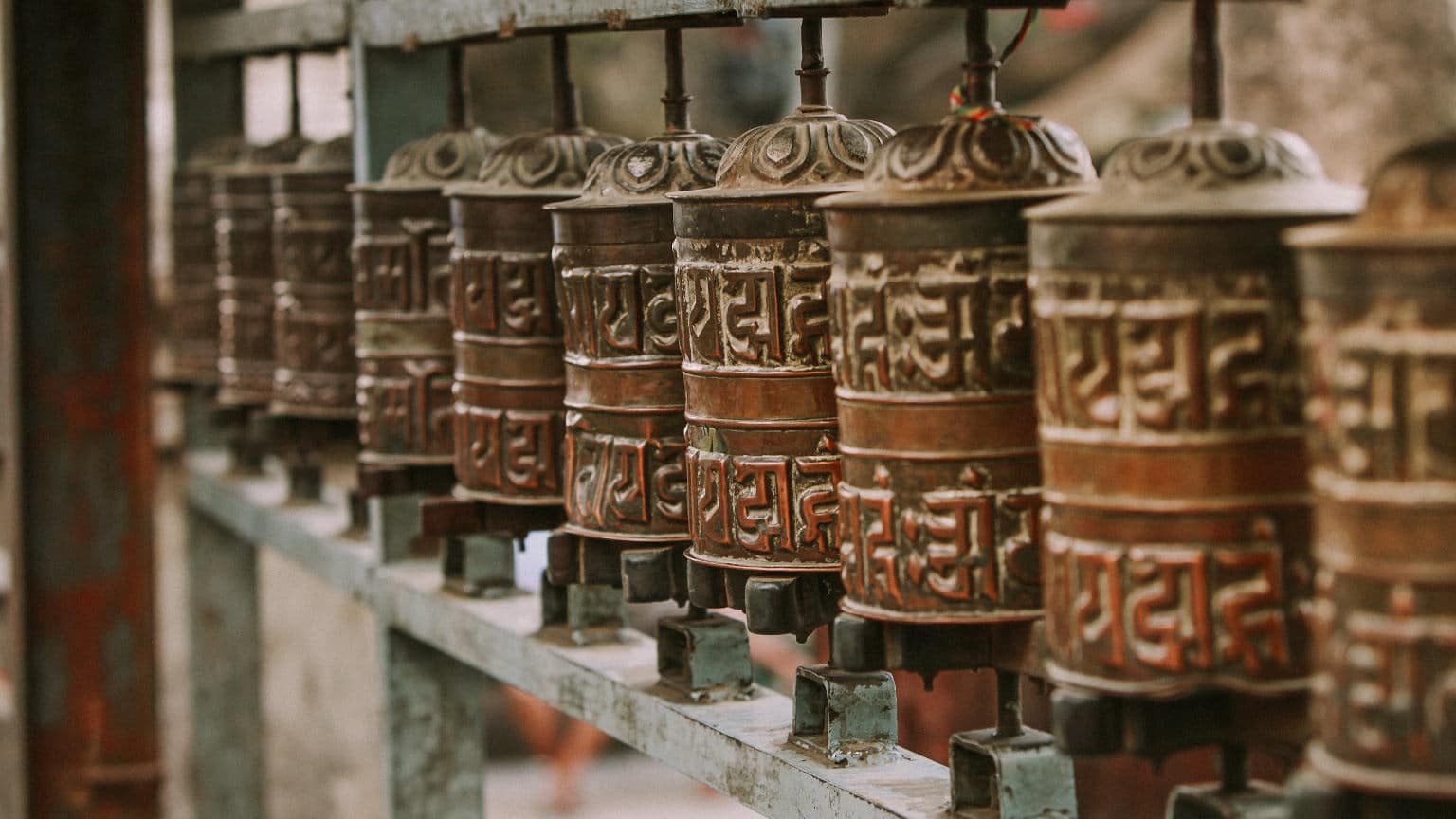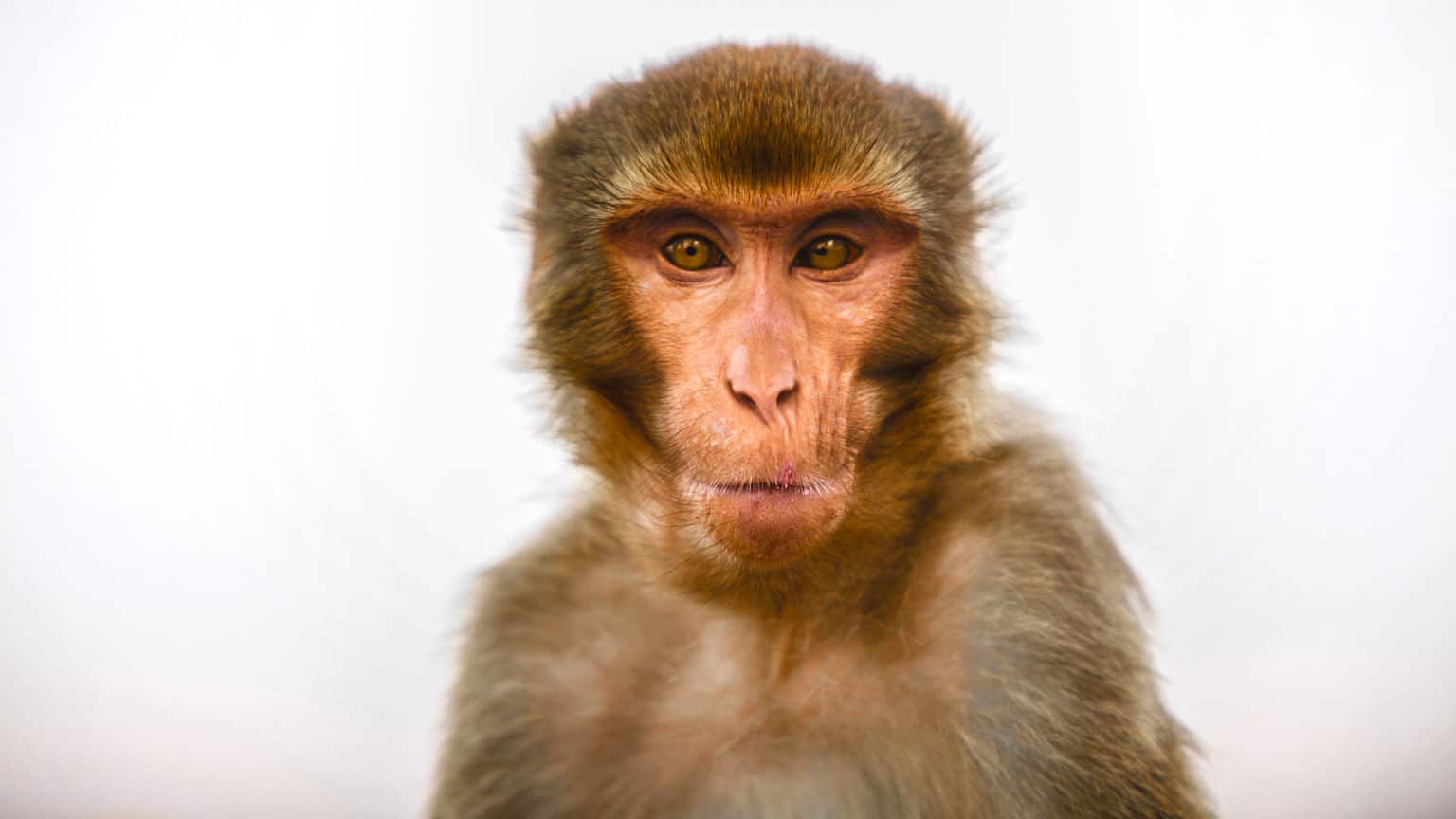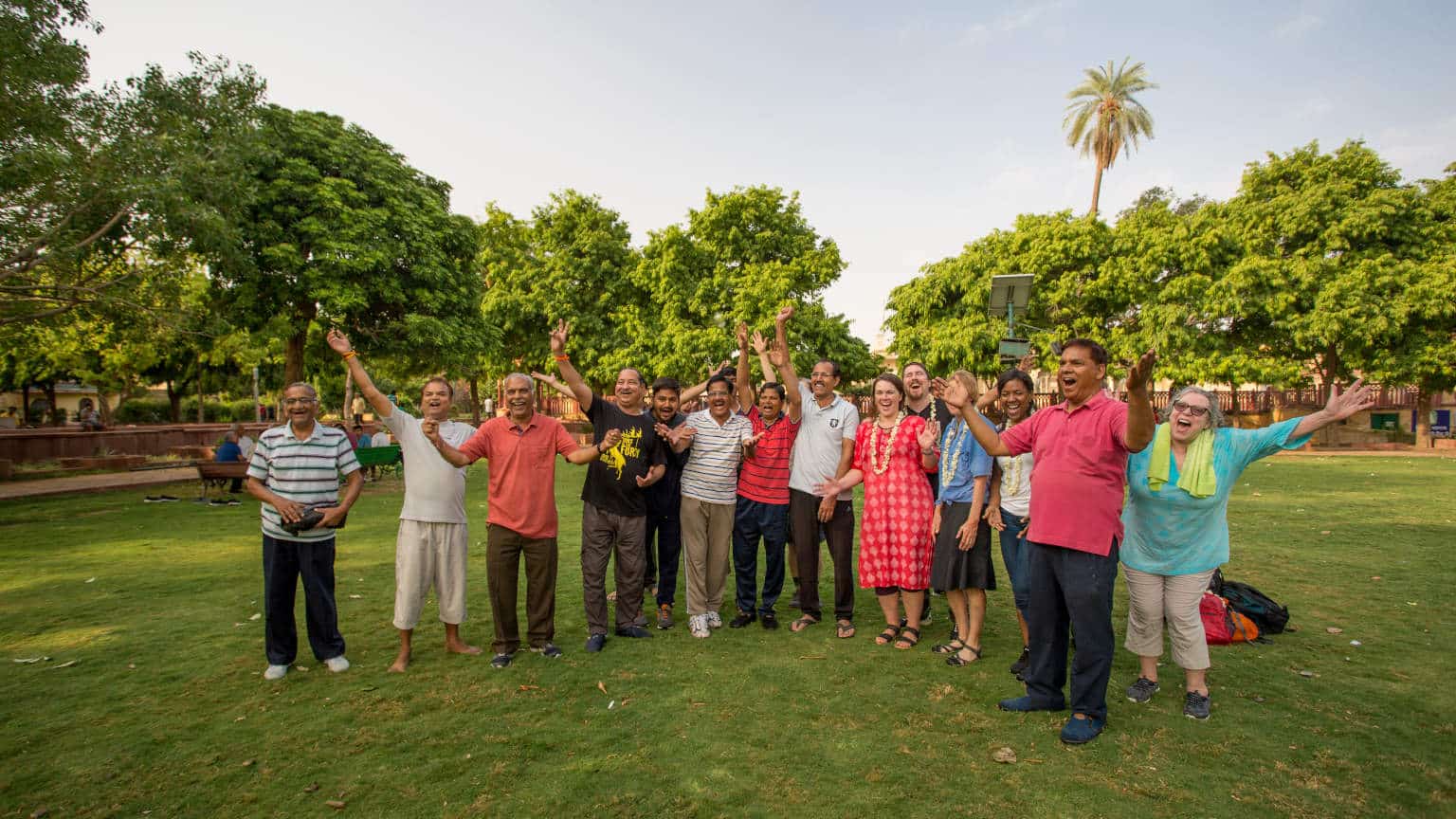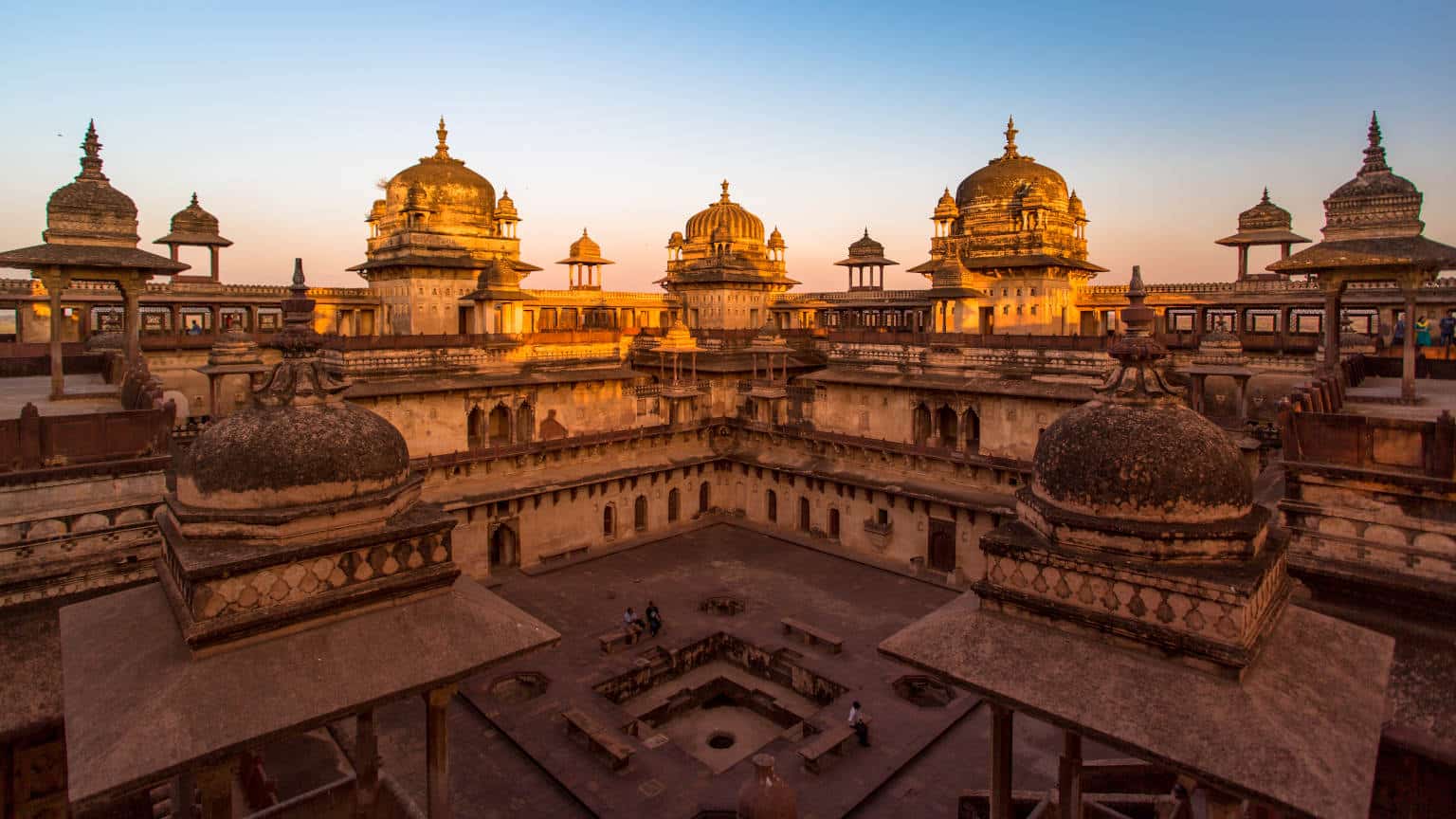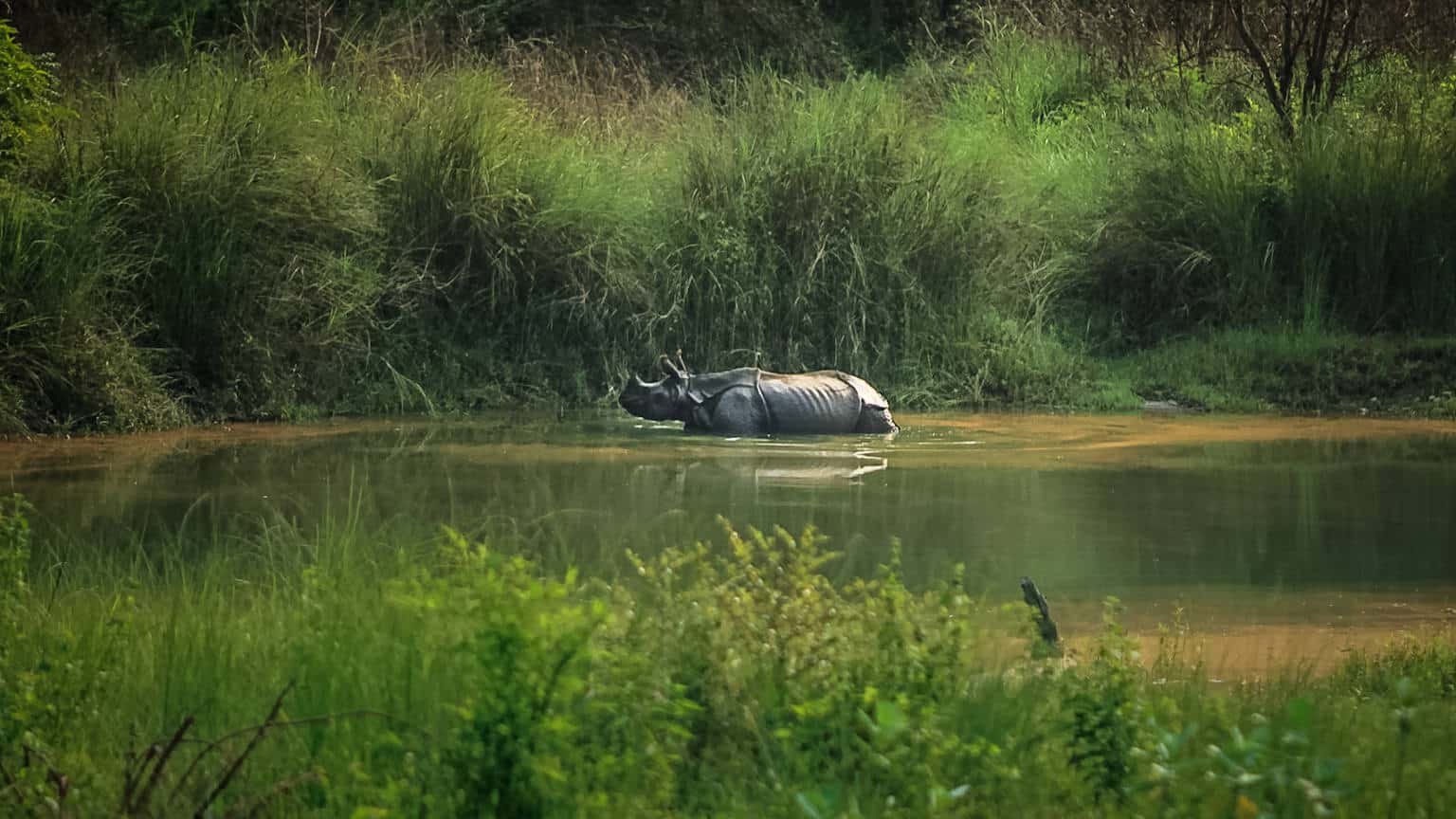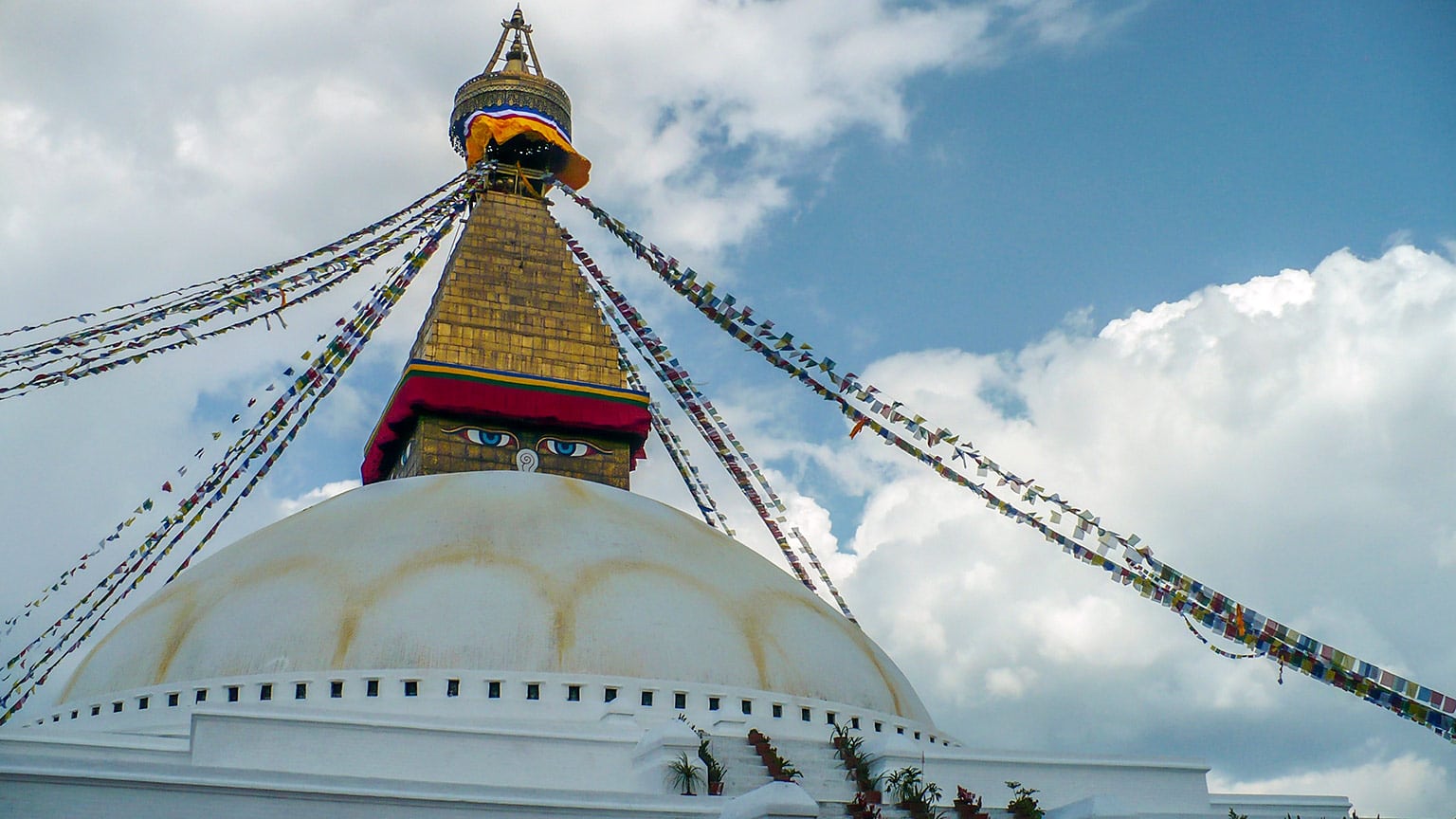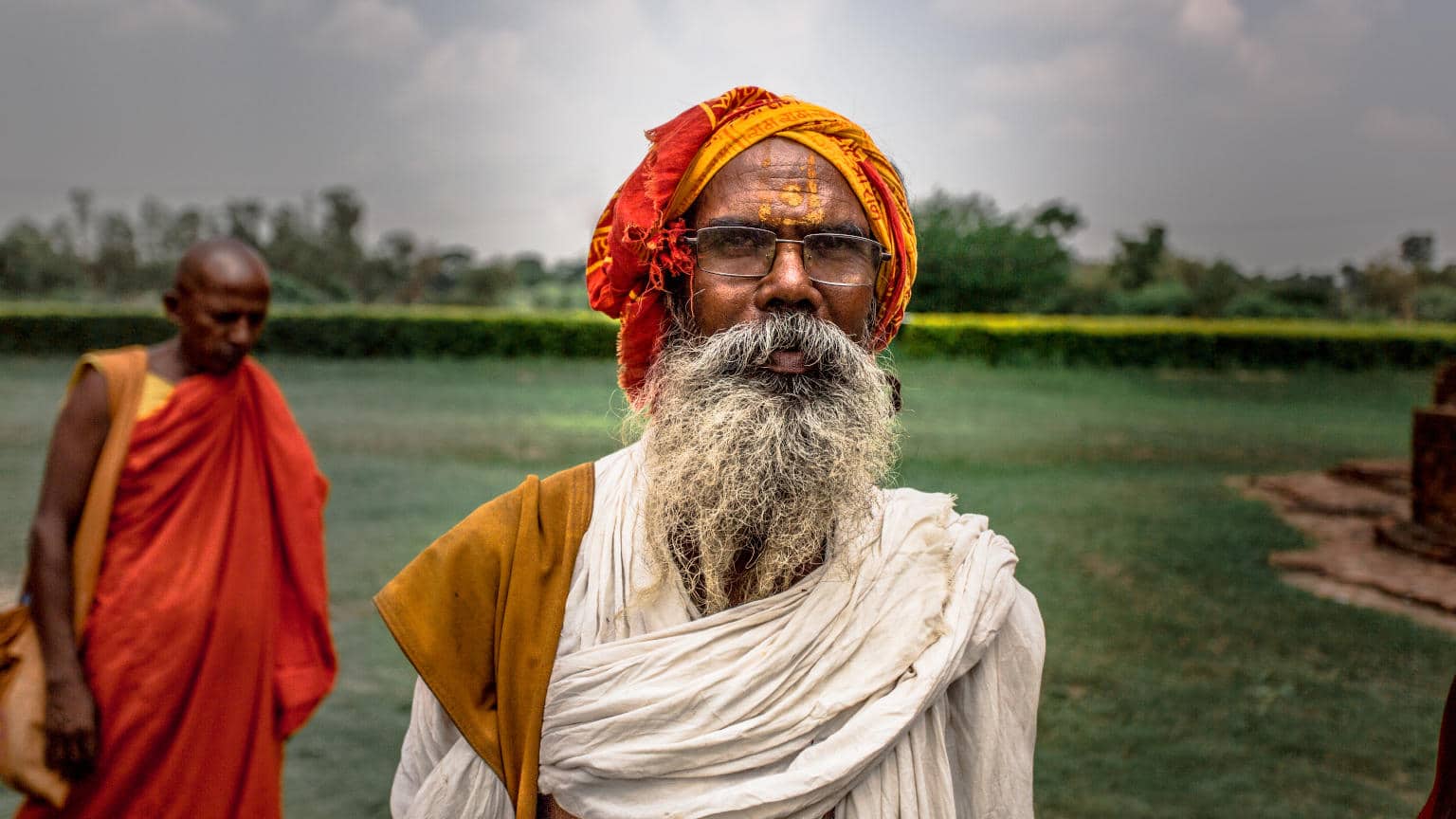Price
 $2489
$2489
This program has been canceled. If you are interested in traveling to India and Nepal on a similar itinerary, we can book travelers on trips with our partner tour operator, G Adventures. You can see available dates here. GEEO can provide a 5% discount (or the best available sale price). Please contact us if you are interested in booking a G Adventures tour to India and Nepal.
Overview
If you’re looking to experience the diversity of India and Nepal, this 17-day trip contrasts the colorful culture of India with the pristine serenity of Nepal’s Himalayan mountains. From the ghats that line the banks of the Ganges in Varanasi to a 4×4 safari in Chitwan National Park, our expert tour leader will take you through a region of unsurpassed natural beauty and spirituality before revealing to you the rugged Himalayan landscape of Nepal’s magical capital, Kathmandu. Visit India and Nepal with us, all while earning professional development credit with other educators.
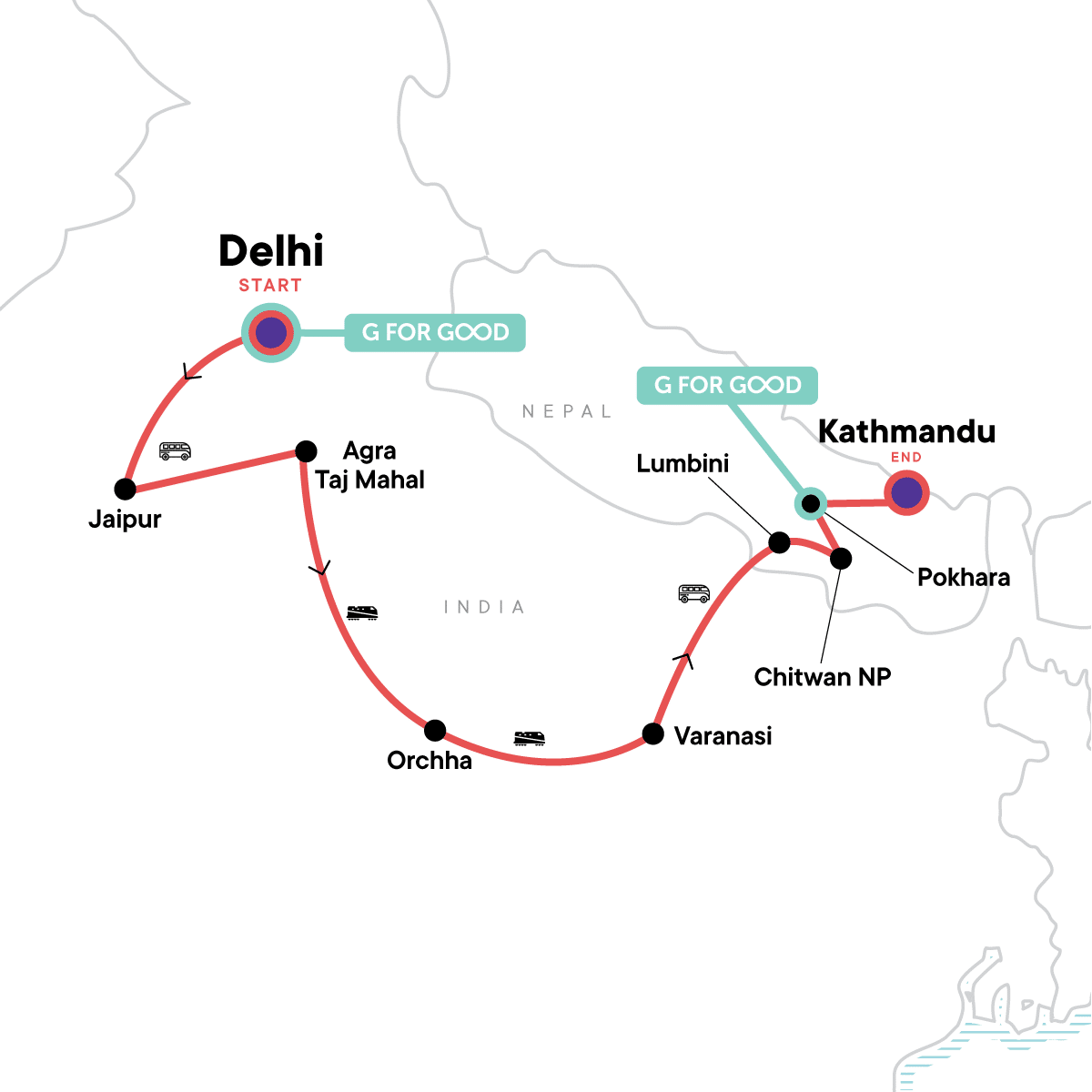
All travelers must undergo temperature screening on arrival in India.
What's Included:
- Arrival transfer included through the G Adventures-supported Women on Wheels project
- Delhi Day tour
- India Gate and Connaught Place visit (Delhi)
- Amber Fort and Hawa Mahal tour (Jaipur)
- Taj Mahal entrance
- Orchha Palace complex visit
- Ganges River boat trips at sunrise and sunset, including candle flower ceremony (Varanasi)
- Varanasi orientation walk along the ghats and old city
- Buddha's birthplace visit (Lumbini)
- Chitwan National Park jeep safari
- Sarangkot sunrise excursion (Pokhara)
- Lunch at the G Adventures-supported Sisterhood of Survivors Project
- Flight from Pokhara to Kathmandu
- Kathmandu orientation walk
- Swayambhunath (Monkey Temple) visit
- Bhaktapur and Patan day tour
- Border crossing support
- G Adventures Tour leader throughout, local guides
- 1 lunch, 1 dinner – allow $400-$520 USD for meals not included
- Upgraded hotels (13 nts), rural village stay (2 nts), sleeper train (1 nt)
- All transport between destinations and to/from included activities by train, metro, local bus, charter bus, private van, auto-rickshaw, cycle-rickshaw, tempo, 4x4, riverboat
What's Not Included:
- International air travel
- Incidentals
- Travel health and cancellation insurance
- Applicable visas
- Tips or gratuities
- Airport taxes
- Beverages
- Meals not mentioned in itinerary
- Optional tours and admissions
- Departure airport transfer
Itinerary Download PDF
Arrive in Delhi at any time. Due to the potential for flight delays or cancellations, we recommend that you plan to arrive in Delhi at least a day in advance. This will also give you time to adjust to the time difference and overcome any jetlag. We can book extra hotel nights for you in Delhi before the trip. For no extra cost, you will be picked up at the airport by Women With Wheels, a non-profit organization that trains Indian women from underprivileged backgrounds to get their professional chauffeur’s licenses. Our tour operator employs all-female graduates to provide our travelers with safe and reliable transportation. We are proud to use our arrival transfers as a means of supporting local Indian women. Please note: If you are coming to Delhi before our program begins and will be staying at a different hotel than the one your tour is using in Delhi, we will not be able to provide you with this complimentary transfer service. Please note that check-in at the hotel is usually around 2:00-3:00 p.m. There are no planned activities until an intro meeting around 6:00 or 7:00 p.m., usually in the hotel lobby. Check for a sign or ask at the reception desk about the exact time and location of the group meeting. Please make every effort to arrive in time for this meeting. If you are delayed and will arrive late, please inform us. Your tour leader will then leave you a message at the front desk informing you of where and when to meet up tomorrow. After the meeting, you might choose to get dinner at a nearby restaurant with your traveling companions and your tour leader to further get to know one another. New Delhi, the capital of India, is one of the most historic capitals in the world, and three of its monuments – the Qutab Minar, the Red Fort, and Humayun’s Tomb – have been declared World Heritage Sites. It offers a multitude of interesting places and attractions to the visitor, so much so that it becomes difficult to decide where to begin exploring the city. We cover some of the city's highlights on the second day of this trip, but we are just scratching the surface of Delhi during this trip. You might consider arriving early if you would like to see more. Beware, however, Delhi is chaotic and intimidating for seasoned and unseasoned travelers alike. In Old Delhi, there are attractions like mosques, forts, markets, and other monuments depicting India’s Muslim history. New Delhi, on the other hand, is a modern city designed by Edwin Lutyens and Herbert Baker. Tree covered wide streets with many roundabouts are notable in New Delhi. Home to many government buildings and embassies, as well as Rashtrapati Bhawan, the one-time imperial residence of the British viceroys, and the India Gate, a memorial raised in honor of the Indian soldiers martyred during the Third Anglo-Afghan War. Further out in the southern suburbs you will discover more history, including: Humayun’s Tomb, said to be the forerunner of the Taj Mahal in Agra; the Purana Quila, built by Humayun, with later-day modifications by Sher Shah Suri; Qutab Minar, built by Qutb-ud-din Aybak of the Slave Dynasty; and the incredible lotus-shaped Bahá’í House of Worship. There are a number of outstanding museums worth visiting including the Craft Museum, the National Gallery of Modern Art, Birla House (also known as "Gandhi Smriti"), and the Indira Gandhi Memorial Museum. Please note: Many museums are closed on Monday. If you are looking to try a range of Indian cuisines, consider visiting the delightful food stalls at Dilli Haat, where the cuisine of different states is available for purchase. Set amidst a spacious crafts bazaar, the cafes of Dilli Haat are a very pleasant place to enjoy food and take in the local culture.
Today, we get to see the sights of Delhi on a full-day guided tour with a local guide. You will ride an air-conditioned bus, although there will be ample walking around and taking a rickshaw. Itinerary will include: India Gate and the surroundings, Old Delhi Chandani Chowk area, Jama Masjid Mosque, Raj Ghat Ghandi Memorial and the Qutab Minar Complex. You will also visit Gurudwara Bangla Sahib, a Sikh temple and kitchen. The temple feeds thousands of people a day with everyone eating on the ground in a big hall. You will go into the kitchen and help roll out Roti, a type of Indian flatbread, to be served. Please keep in mind that Delhi traffic is unpredictable, so plans may need to be adjusted. Please note: Qutab Minar's entrance fee isn't included. Participants will pay 250 INR locally (roughly $5 USD). Raj Ghat is occasionally closed to the public for official ceremonies.
Leaving the chaos of Delhi, we board our early morning air-conditioned bus to Jaipur, known as the "Pink City." Jaipur was first painted terracotta pink by Maharajah Sawai Ram Singh in 1853, to celebrate the visit of Prince Albert. We will have an orientation walk and then have the option to take in a Bollywood film at the Raj Mandir, a spectacular art deco film house. Approximate travel time: 6 hrs by private vehicle
This morning, we visit the Amber Fort, which clings to the surrounding hills, marveling at its beautiful Hindu and Muslim architecture. We then travel back to Jaipur to see the Hawa Mahal, or the "Palace of the Winds." This famous building is in fact only an elaborately carved facade built to enable the purdah ladies in the zenana to watch the goings-on in the street below without being seen. There are so many things to do in Jaipur, and you will have some free time to choose what is most of interest to you. You may want to explore by bicycle, which will introduce you to sights, sounds, and smells that a vehicle just can't match. Marvel at the architectural wonders as you enter the walled part of the city and stop at the City Palace to visit the Govind Dev temple. Wander through the historical spices and sweets market, stopping for tea and a tasty snack of pakoras before heading towards the majestic Albert Hall Museum where the cycle tour ends. You might instead prefer to head out to the nearby village of Sanganer to see blue pottery, handmade paper, or hand-block printing. Or you may wish to discover more of the wisdom and history of the Mughals by wandering around the Jantar Mantar, an observatory built in the 1700s. We also recommend visiting the courtyards, gardens, and buildings that make up the City Palace. Located in the heart of the Old City, it is a striking blend of Mughal and Rajasthani architecture. Visit the palace's museum to look at ancient carriages and the former maharaja's gold-embroidered wedding outfit. Jaipur is one of the most important centers in the world for gems, jewelry, and small diamonds. It is also a great place to buy block-printed textiles, blue pottery, and handmade paper. There are many shops selling these items and some wonderful markets in the Old City selling more traditional items such as mojari, Rajasthani slippers. If buying gems or jewelry, please take caution as there have been several instances of scams where fake jewelry has been passed off as real.
Travel to the city of Agra, site of India’s most famous landmark, the Taj Mahal. Visit this icon of Mughal architecture in the late afternoon for the best light. The Taj Mahal was constructed between 1631 and 1654 by a workforce of 22,000 laborers. It was built by the Muslim Mughal Emperor Shah Jahan as a mausoleum for his favorite wife, Arjumand Bano Begum, better known as Mumtaz Mahal. Mumtaz had already borne the emperor 14 children when she died in childbirth, and it is the romantic origin of the Taj as much as its architectural splendor that has led to its fame worldwide. Actually an integrated complex of many structures, the Taj Mahal is considered the finest example of Mughal architecture, itself a combination of Islamic, Hindu, Persian, and Turkish elements. Approximate travel time: 6 hrs by private vehicle
Today, we travel by train from Agra to Jhansi before jumping in a tempo, a large auto-rickshaw, to the picturesque town of Orchha. You will love the peaceful rural charm of this riverside town. Sitting on the banks of the Betwa River, Orchha is the perfect antithesis India’s bustling cities. Experience a part of India that will likely change your perception of this diverse country. A typical, small Indian town, Orchha owes its popularity to an architectural heritage that shows the town's history as the oldest and highest in rank of all the Bundela states. Orchha dates back to the 16th century when it was founded by the Bundela chief Rudra Pratap. In the early 17th century, Raja Jujhar Singh rebelled against the Mughal emperor Shah Jahan, whose armies devastated the state and occupied Orchha from 1635 to 1641. Orchha was the only Bundela state not subjugated by the Marathas in the 18th century. Hamir Singh, who ruled from 1848 to 1874, was elevated to Maharaja in 1865. Maharaja Pratap Singh, who succeeded to the throne in 1874, devoted himself entirely to the development of his state, including designing most of the engineering and irrigation works built during his reign. We will visit the Orcha Palace complex, which is three separate palaces or mahals: the Raj Mahal, Jehangir Mahal, and Rai Parveen Mahal. Enjoy the medieval architecture and learn about its rich history. In the evening, if you wish, you may join an evening puja, a Hindu prayer ceremony. Approximate travel time: 2.5 hrs by train (Agra to Jhansi); 1.5 hrs by auto-rickshaw (Jhansi to Orchha)
We will start the day with a visit to Tarragram, a unique paper-making plant that is set up to assist tribal women from the area. All the paper here is made from recycled clothing and wood pulp. You can opt to rent a bike from a local shop and head out to explore. Or you can take a cooking class with a local family and enjoy the fruits of your labor for lunch. This home-cooked meal is a real highlight and is highly recommended by past participants. In the evening, you will return to Jhansi, where you will board an overnight train to Varanasi. See our FAQ to learn more about the overnight train, which is an essential Indian experience and a great way to see the landscape. Approximate travel time: 30 mins by auto-rickshaw (Orchha to Jhansi); 13 hrs by overnight train (Jhansi to Varanasi)
We arrive in the morning at Varanasi, the quintessential Indian holy city, where millions of Hindus travel for pilgrimage, to worship, to mourn, or to die. The legends, myths, and aura surrounding Varanasi led Mark Twain to remark famously that the city "is older than history, older than tradition, older even than legend and looks twice as old as all of them put together." Sitting on the banks of the River Ganges, you can contemplate what it means to be in Varanasi, the oldest continually-inhabited city in the world, dating back thousands of years. The culture of Varanasi is deeply associated with the Ganges River, its reigning deity Lord Shiva, and its religious importance: the city has been a cultural and religious center in northern India for thousands of years. When we first arrive, we will have an orientation walk along the ghats and through the old city, filled with temples, shrines, and Hindus from all over India and the world. Enjoy views of the sacred River Ganges. During your free time after the orientation walk, you might choose to visit some of the hundreds of temples and shrines, such as the Lord Hanuman Temple Visit honoring the Hindu monkey-god, Hanuman. Perhaps you could visit the monasteries and ruins of nearby Sarnath, the site of Buddha's first sermon and one of the most holy sites to Buddhists. It is said that, after attaining enlightenment at Bodh Gaya, Buddha continued to Sarnath. In a deer park, he preached his first discourse and set in motion the Wheel of the Dharma. During our stay, we take an evening boat tour on the sacred Ganges River and participate in a candle and flower ceremony while on the water. Please note: Varanasi can be a difficult city to visit, even for an experienced traveler. Varanasi requires patience and an open mind, but it is worth it!
Today, we wake up early and catch the sunrise during another boat ride on the sacred Ganges River, where Hindu pilgrims from all over the world come to wash away their sins and cremate their loved ones. Witness locals participating in dawn rituals of bathing and burning at the river. You will then have more free time to explore this holy city.
Today, we have a long travel day as we cross into Nepal. Enjoy the changing landscape and get ready to learn about the history and culture of Nepal. You will receive a Nepalese visa at the border, but you will need $30 USD in crisp, new bills. Also be aware that Nepal is 15 minutes ahead of India. After completing the immigration formalities in both India and Nepal, we will drive to Lumbini, the historical birthplace of Gautama Buddha, the founder of Buddhism, who lived between approximately 563 and 483 BCE. Lumbini is located 25 km east of the municipality of Kapilavastu, the place where the Buddha grew up and lived up to the age of 29. We will explore some of the numerous monasteries in this UNESCO World Heritage Site. Approximate travel time: 6 hrs by train; 2-3 hrs by taxi; 30 mins-1 hr by private vehicle.
Travel through a region that is home to rhinos, elephants, Bengal tigers, bears, and leopards. In the evening, meet the local Tharu community and discover their culture. Experience their culture through dance and song, along with a traditional meal. Opt to go on a cycling excursion through the area. After breakfast, we will drive through a belt of marshy grasslands, savannas, and forests at the base of the Himalayas to Chitwan National Park, another UNESCO World Heritage site. We will be welcomed by the indigenous tribal group of Chitwan, the Tharus. In the evening, we interact with the local Tharu community and experience their culture through dance and song along with a traditional meal. The Tharus are an indigenous community of the Terai belt of Nepal and work toward living self-sufficiently. They live in eco-friendly homes made of mud, straw, and other materials found in abundance in the region. They also produce and farm all their own food. We will stay overnight in a jungle resort. Approximate travel time: 4-5 hours by private vehicle
Today, we will explore the diverse ecosystems of Chitwan National Park, formerly the "Royal Chitwan National Park," from the comfort of a 4x4 vehicle. Keep your eyes peeled for the many animals that live there, including birds, monkeys, crocodiles, and rhinos. If you're lucky, you might even see an elusive tiger. Keep in mind that sometimes the wildlife is hard to spot, so keep your expectations low. We will stay overnight in a jungle resort.
Travel from the plains to the mountains by private vehicle. Nestled in a tranquil valley at an altitude of 827 m, Pokhara is a place of natural beauty. The serenity of Phewa Lake and the magnificence of the fish-tailed summit of Machhapuchhre (6,977 m) rising behind it create an ambiance of peace and tranquility. We will have an orientation walk in Pokhara led by your tour leader. Pokhara lies on a once vibrant trade route extending between India and Tibet. To this day, mule trains can be seen camped on the outskirts of the town, bringing goods to trade from remote regions of the Himalayan mountain range. This enchanting city has several beautiful lakes and offers stunning panoramic views of the surrounding peaks, creating an ambiance that makes it such a popular place to relax and enjoy the beauty of nature. Relax in a café, hire a boat to float around the lake, or shop for Nepali and Tibetan souvenirs in the endless stalls and shops. Approximate travel time: 5-6 hrs by private vehicle
This morning, we travel to Sarangkot (1,592 m) only 5 km northeast of Pokhara, for a spectacular sunrise of the surrounding mountains (weather permitting). The most stunning of Pokhara’s sights is the spectacular panorama of the Annapurna range, which will dominate the scenery during the walk. The walk also takes you back to Pokhara through farms and forests and is a wonderful way to spend 2-2.5 hours. After the walk, we visit the Sisterhood of Survivors Project, a G Adventures-supported grassroots organization that is helping to support rehabilitated survivors of human-trafficking and other at-risk women. SASANE, our project partners, trains once vulnerable women to be certified paralegals, so that they are the first point of contact for other women coming out of abuse. G Adventures has helped catalyze a hospitality program for these women to be reintegrated into a dignified work environment. The survivors will teach you how to make momos (traditional dumplings) and then enjoy a Nepali lunch together. This program helps support SASANE's trafficking prevention and re-integration programs across Nepal. In the afternoon, you have free time to explore Pokhara on your own.
Today, we travel by airplane to Nepal’s magical capital and largest city, Kathmandu. For many, simply the name alone is sufficient to conjure up images of temple pagodas, long-haired saddhus in clouds of hashish smoke, and the ever-present Himalayas. Kathmandu is all this and more. Sitting in a bowl-like valley surrounded on all sides by some of the highest mountains on earth, Kathmandu has been a crossroads of cultures since hundreds of years before Christ, a tradition very much alive today. Upon arriving in Kathmandu, we will enjoy a short orientation walk. As a group, we will visit Swayambhunath Temple (Monkey Temple). Highlights in Kathmandu include world-famous Durbar Square, the King’s Palace, the burning ghats at Pashupatinath, and the Boudhanath Stupa. Approximate travel time: 30 mins by airplane
Kathmandu, Patan, and Bhaktapur constitute the valley’s three medieval Newari cities. Today, our group will go on a guided tour of Bhaktapur and Patan. Bkahtapur is the best preserved of the three cities, with incredibly well-preserved ancient architecture, much of which withstood a devastating earthquake in 2015. The ancient town, known as the City of Devotees, was founded in the 12th century and became renowned for its culture, festivals, and multitude of Hindu temples. Explore Bhaktapur's markets, tea stalls, wood-carved temples, and vibrant squares, including Durbar Square. You can pick up clay pots and other souvenirs in the colorful open markets and taste homemade yogurt, known as khopa dhau, which Bhaktapur is famous for. We will also visit Patan's Durbar Square and the Golden Temple. South of the square lies the Kumari Chowk, home to Nepal's living goddess, the Kumari. The Kumari, a prepubescent girl chosen as the incarnation of the Hindu goddess Talejn, lives a cloistered life, rarely leaving the confines of the chowk. When she does leave, it is only for important religious festivals, and her feet are not allowed to touch the ground. Once the Kumari reaches puberty, another 3- to 5-year-old girl will take her place. Approximate travel time: 1 hr by private vehicle
There are no planned activities today, so you may depart Kathmandu at any time. If you wish to extend your stay in Kathmandu, consider booking post-tour accommodation with us. Please note: If your departure flight is earlier than 2:00 p.m., you will not have time for an optional Mount Everest flight this morning. (See the optional activities section below for more information about this flight.) Please note that check-out time from the hotel is usually mid-morning, but luggage storage services are available at the reception desk. Want more adventure? Book two or more GEEO programs in the same school year and receive a discount! GEEO will give you 10% off of the lesser value program(s) (up to 3 programs per year). If you would like to extend your time abroad but don't see another GEEO program that interests you, let us know. We can work with you to find a trip from our tour operator’s much larger catalog. Their tours are open to the general public and not designed specifically for educators, but we can still offer you and your travel companions a discounted educator price on any additional tours that you book.
Details
Frequently Asked Questions
Please read our general FAQs, where you can find essential information that applies to all of our programs.Resources to Learn & Teach about India & Nepal
Visit our recommended reading page to see the list of books GEEO recommends reading before your program (this is not required reading). We also have lesson plans and Pinterest boards that may be useful for you as you learn about your destination and prepare to bring lessons back to your classroom.Terms and Conditions
It is very important for you to visit our Terms and Conditions page before signing up for this program.GEEO Program Confirmation Process
We require a minimum of 6 participants for most GEEO programs. We officially confirm that a program will run once at least 8 people have signed up, which provides a margin for individual cancellations. Nearly all GEEO programs ultimately meet this enrollment quota, and in the rare event that a program does not meet the minimum requirement and GEEO cancels the program, we will work with you to find a suitable alternative or provide a refund of your deposit if you prefer. We encourage you to sign up for any program that interests you, and we will notify the entire group once 6 people are booked and again once 8 people are booked. We always emphasize the importance of exercising caution when making non-refundable travel arrangements, especially given the unpredictable nature of travel. For example, we typically recommend booking flights with flexible change/cancellation policies.Cancellation policy
All cancellations must be submitted to GEEO in written form by emailing your request for cancellation to travel@geeo.org. If you do not receive a confirmation that we have received your written cancellation request, please call us at 1-877-600-0105. Verbal cancellation requests will not be honored.- If you cancel 60 days or more prior to departure, all your program fee payments will be refunded besides your $350 deposit which is kept on file for future use
- If you cancel between 30 and 59 days prior to departure, you will receive a 50% refund and your deposit is kept on file for future use
- If you cancel within 30 days of departure, you will receive no refund, but your deposit is kept on file for future use
Trip Notes
- India is a country that is very different from anything you will have experienced before. Although this means it is not the easiest place to travel, this is also what makes it so special. Pollution, poverty, and the crowds can result in initial culture shock but should be seen as an exciting new challenge. During our time here, we have come to love this large and wonderfully different country, but we know that we should always expect to encounter some difficulties along the way.
- In India, there are very different attitudes to timekeeping, public cleanliness, privacy, and service. Trains will sometimes be late, plumbing can sometimes be temperamental, and power will often just vanish. Optimistic menus turn out to have only one dish available and everyone – everyone – will want to know your name. If you are able to travel with a lot of patience and a healthy sense of humor, we know that you – like all of us – will be captivated by what India has to offer.
- Please be careful about attracting too much attention to the group in large cities. An innocent conversation with a local man in a train station can result in the group being surrounded by 40 curious men who also want to talk or be in the group's physical space. It can get really uncomfortable even if they mean no harm. You will always attract attention as a westerner. Please ask your tour leader what is appropriate before interacting with local men.
- We upgraded accommodation on this program compared to the hotels our tour operator G Adventures typically uses on this itinerary. It costs a bit more, but our guests have been very happy with the change. We will still have an overnight train and the homestay, so not all of the accommodation has been upgraded.
- Please note that drones and the flying of drones are prohibited in Nepal. If you violate these regulations, the police may take you into custody.
Mental Preparation
Of all of GEEO’s programs, this is probably the one that causes the most culture shock. India and Nepal are thick with history, wonders, smells, colors, dirt, and bureaucracy the likes of which even experienced travelers have never encountered. It is amazing and at the same time overwhelming. You will see poverty. You will feel uncomfortable. You will probably get diarrhea. India takes some getting used to for most people, and the sooner you mentally adjust to the environment, the sooner you will be able to enjoy yourself.Group Leader Description
All GEEO/G Adventures group trips are accompanied by one of G Adventure’s group leaders, which they refer to as Chief Experience Officers (CEOs). The aim of the group leader is to take the hassle out of your travels and to help you have the best trip possible. They will provide information on the places you are traveling through, offer suggestions for things to do and see, recommend great local eating venues, and introduce you to our local friends. Our itineraries often have plenty of free time to explore on your own. While not being guides in the traditional sense, you can expect them to have a broad general knowledge of the countries visited on the trip, including historical, cultural, religious, and social aspects. We also use local guides where we think more specific knowledge will add to the enjoyment of the places we are visiting – we think it’s the best of both worlds.Fitness Level
This trip includes light walking and hiking that is suitable for most fitness levels. The hardest element to deal with is the heat and humidity. We have been running this program over the summer for several years, and while the weather is not ideal, the trip always receives great reviews.Single Travelers
Half of GEEO’s participants travel by themselves, so please don’t worry if you do not have a travel companion for your trip. Our program fee is for one traveler in double-occupancy accommodation, and GEEO can find you a roommate of the same gender if you do not have a travel companion. Most of our programs have a “My Own Room” option, also known as a “Single Supplement,” which is an extra fee that you can pay to have a room to yourself. You will only incur an additional charge if you specifically request a single room. To see the price for the “My Own Room” option, please find your program on our extra services page. If you want to room alone, please email travel@geeo.org to request a single room.Joining Instructions
Day 1 is an arrival day, and no activities have been planned. Upon arrival to the city on Day 1, or earlier if you have booked pre-accommodation with us, please make your way to the joining hotel. Please note: Check-in time will be in the afternoon. Once you arrive at the hotel, look for a note at reception from your tour leader. This note will give the details of your Welcome Meeting on Day 1, usually between 6:00 p.m. and 7:00 p.m., during which you will get a chance to meet your tour leader and other travelers, as well as learn more about how the tour will run. If you don’t see a note, please ask reception for details. If you miss the Welcome Meeting, your tour leader will leave a note at reception for you with any information you may need and with instructions for the next morning. For no extra cost, you will be picked up at the airport by Women With Wheels, a non-profit organization that trains Indian women from underprivileged backgrounds to get their professional chauffeur licenses. Our tour operator then employs all female graduates to provide our travelers with safe and reliable transportation. We are proud to use our arrival transfers as a means of supporting local Indian women. Please note: If you are coming to Delhi before our program begins and will be staying at a different hotel than the one your tour is using in Delhi, we will not be able to provide you with this complimentary transfer service.Emergency Contacts
Should you need to contact G Adventures during a situation of dire need, it is best to first call their local G Adventures office. If for any reason you do not receive an immediate answer, please leave a detailed message and contact information so they may return your call and assist you as soon as possible. EMERGENCY CONTACT NUMBERS G Adventures Local Office (Delhi) G Adventures South Asia Manager, Rishab (Delhi, India) Emergency number: From outside of India: +91 99 7179 5447 From within Delhi: 99 7179 5447 From within India, but outside Delhi: 099 7179 5447 G Adventures Asia Office in Bangkok (If for some reason you can’t reach any of India emergency numbers) 8:00 a.m.-6:00 p.m. CST (GMT +7) Tel: +66 2 252 6642 If for any reason you are unable to reach the G Adventures local office, please call the numbers listed below to connect with their Sales team, who will happily assist you. Toll-free, North America only: 1 888 800 4100 Calls from UK: 0344 272 0000 Calls from Germany: 0800 365 1000 Calls from Australia: 1 300 796 618 Calls from New Zealand: 0800 333 307 Outside North America, Australia, New Zealand, Germany and the UK: +1 416 260 0999 If your call is specifically concerning Airport Transfer complications, please call the local transfer provider directly: From outside India: +91 9278708888 From within Delhi: 9278708888 From outside Delhi: 09278708888 Airport Representative From outside India: +919599193260 or +919599051397 From within Delhi: 9599193260 or 9599051397Packing List
Please read this article on GEEO’s blog for our staff’s suggestions on the best gear to pack for your upcoming travels. You must be prepared to carry your own bags and be comfortable carrying them up and down stairs, on and off transportation, and to hotels. As a rule, we try not to have to walk more than 15-20 minutes with your bags, which is why we recommend keeping the weight of your bags between 22-30 lb. Most travelers carry a backpack or rolling bag of small to medium size. No XXL bags please! A daypack is also essential for carrying everyday items. Space is limited on transportation, so there is a limit of one main piece of luggage per person plus a daypack per person. Health & Safety- N95/KN95 face masks (at least a few just in case there is an outbreak within your group)
- Hand sanitizer
- Rapid Covid tests/antigen tests (at least 3)
- Clothes for religious sites – knees and shoulders must be covered
- Small towel and swimwear
- Raincoat and/or umbrella
- Personal clothing for hot weather – we recommend packing 8-9 days of outfits, so you only have to do laundry once; covering shoulders is advisable
- Shorts – covering knees is advisable for women; some would say men too
- Long pants
- Sturdy walking shoes – closed-toe is a good idea
- Sport sandals or flip-flops
- Daypack
- Insect repellent
- Sunblock
- Sunglasses
- Sun hat
- Watch or alarm clock
- Toiletries – your hotels will have soap and shampoo
- Camera
- First-aid kit, including: lip salve, aspirin, bandaids, anti-histamine, Dramamine, Imodium or similar tablets for mild cases of diarrhea, electrolyte powder, insect repellent, extra prescription drugs you may be taking
- Silk sleep sack – very nice to have on the train
- Travel pillow
- Lock for all bags
- Flashlight or headlamp
- Money belt
- Water bottle
- Phone/tablet for internet – most hotels have WiFi
- Chargers for electronics as well converters/adapters, if needed
- AirTags or Tile trackers
- Packing cubes
- Earplugs
- Snacks – packing a few granola bars is a good idea; you can buy snacks when you get there too, so don’t go crazy here
- Ziplock bags for wet clothing
- Reading/writing material
- Hand sanitizer/baby wipes
- Headscarf for women
- Light fleece top
- Cover for backpack or plastic bags to keep clothes dry
- Passport (with photocopies)
- Any entry visas or vaccination certificates required
- Travel insurance ID card
- Flight itinerary/boarding pass(es)
- USD/EUR cash
- Credit/debit card
- G Adventures vouchers
- GEEO Classroom action plans for your group – this is sent a few days before departure
Laundry
Laundry facilities are offered by some of our hotels for a charge, or you can ask your tour leader where the nearest laundromat is located. In case you want to do your own laundry, we suggest you bring your own non-polluting/biodegradable soap.Passports and Visas
All GEEO programs require that the participant have a valid passport. Please see our general FAQ for information on obtaining a passport. As with all of our trips, we try to provide the most accurate information we can, but governments sometimes change visa rules. It is your responsibility to double check the information we provide below by searching here. U.S. citizens must purchase a visa in advance before traveling to India. India has an e-visa system that makes the process quite easy, and you do not have to send your passport to an embassy. The 30-day India tourist e-visa costs $10 (April to June) or $25 (July to March). Although you can apply a maximum of 30 days (and a minimum of 4 days before your arrival in India), we strongly recommend waiting to apply once you are 25-20 days before your scheduled arrival date. If you receive a visa that expires the day after you are scheduled to arrive in India, and then you experience flight delays/cancellations that cause you to arrive later than scheduled, you could be denied entry to the country. To apply for a visa, please go to https://indianvisaonline.gov.in/visa/tvoa.html and follow the instructions carefully. GEEO will provide further instructions approximately one month before your program is scheduled to begin. For Nepal, you will have your photo taken and receive a visa at the border. A single-entry 15-day tourist visa can be obtained by paying $30 USD (must be crisp, new bills), and you will need at least one empty page in your passport. They do not give back any change, so make sure you have a crisp $10 bill and a crisp $20 bill.Money Exchange
The local currency in India is the Indian rupee (INR), and the local currency is Nepal is the Nepalese rupee (NPR), although the Indian rupee is also widely accepted. As currency exchange rates fluctuate, we ask that you refer to the following website for daily exchange rates: www.xe.com. We recommend that you obtain cash from ATMs while traveling; they will dispense the local currency. We do, however, recommend that you bring at least $200 USD in cash for emergency use or in case you have trouble with the ATMs. Major credit cards are accepted in most shops, but you may be charged an international transaction fee; ask your financial institution about their international fees. Please note that if you are carrying U.S. dollars, the bills should be in good condition (i.e., not torn, wrinkled, or marked on in any way) and dated recently.Tipping
It is customary in South Asia to tip service providers such as waiters, at approximately 10%, depending on the service. Tipping is an expected, though not compulsory, component of this program and an expression of satisfaction with the people who assist you on your trip. Tipping is also one of the most direct ways that you can have a positive economic impact within the local community. Although it may not be customary to you, it is of considerable significance to the people who will take care of you during your travels. Your tour leader will offer to collect the money and distribute the money to service workers throughout your trip. Altogether these tips end up around $70 USD. At the end of your program, if you felt your G Adventures tour leader did an outstanding job, a tip would be appreciated. The amount is entirely your personal preference, but as a guideline, $20-30 USD per person per week would be appropriate. We recommend tipping your tour leader in crisp USD bills.Vaccinations
GEEO cannot provide any medical advice, so it is very important to consult your doctor or a travel clinic about which vaccinations you will need for your trip. We recommend contacting Passport Health (http://www.passporthealthusa.com/), which has travel clinics located throughout the United States. You can also check the CDC's recommended vaccinations for your destination. Please take this seriously!Flights
We find the best prices for flights are often available around 90 days before departure, but of course this varies greatly from route to route and year to year. You should wait until this trip is confirmed before you book non-refundable flights. GEEO and G Adventures bear no responsibility for any flights purchased before the trip is confirmed. This program begins in Delhi and ends in Kathmandu. Please double-check our itinerary for the date by which you must arrive in Delhi. You may want to arrive in Delhi one or more days early in case you have flight disruptions. You can arrive at any time you choose, but try to make it in time for our 6:00 p.m. Welcome Meeting on Day 1. You can depart from Kathmandu any time on the final day of the program. For about $100, you can book a short flight from Kathmandu to Delhi, in which case you could buy a round-trip flight from your home city to Delhi.Plugs and Converters
There are two components to provide external power to your device: adapters and transformers (also called electrical converters). The adapter is for your device's plug, adapting the prongs on a standard U.S. two- to three-pronged power cord to fit the local outlets. The transformer/converter changes the local voltage to the voltage used in the U.S. India and Nepal use Type C and D plugs with two or three circular prongs, respectively, and the voltage is 230V. (Standard U.S. electrical outlets are 120V.) Most new devices, including phones and laptops, are made to work with the different voltage rates, but some devices, like hair dryers, may only work on the U.S. standard of 120V. Check your device's plug or manual to see what voltage range it requires. Most transformer blocks will have an “Input” line that defines its voltage capacity; for example, “Input: 100-240V” means that it will work with voltages between 100V to 240V. If your device can’t handle the higher voltage, you’ll need to purchase a transformer/converter. You can find world transformers/converters online or at many retail stores in the travel section.Expectations
Before you decide to travel with GEEO, it is important that you read all of the information about the program you are considering. Remember, our programs are quite adventurous.- We will be using upgraded hotels during this program. However, this is India so keep your expectations low as service level and amenities are often different than Western standards. The purpose of the accommodation is to provide a safe place for you to sleep. Sometimes you will be pleasantly surprised, but do not expect luxury.
- The same goes for transportation. We use a mix of transportation that gets our guests from location to location safely. Sometimes you will have full days and nights of transportation as our trips tend to cover a lot of ground. Transportation will often be an adventure in itself.
- You must be able to carry or roll your luggage easily, so do not over-pack.
- Many of our programs occur in locations where it is very hot during the day. Please make sure you have thoroughly read the itinerary and can handle the group activities, which sometimes include day hikes with your daypacks.
- We recommend always carrying snacks with you. Meals can sometimes be far apart.
- Please make sure you understand the role of your tour leader on this trip as they are not the traditional “guide” you may be expecting. While our trips are educational, they aren’t study/lecture trips. We want you to learn through exploring and much of your experience will be based on how active you choose to be in acquiring knowledge and interacting with locals.

